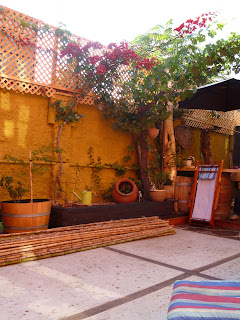Although Santiago certainly has its redeeming qualities, Pucon was a tough act to follow. I’ve verified my distaste for concrete jungles, as most seem to have the same characteristics to offer—typically, lots of statues, plazas, people, and smog. Santiago, a somewhat cleaner, less populated, and safer city than Buenos Aires, had a bit less to offer than Argentina’s biggest concrete jungle.
We spent the day with a Canadian couple who we met at the hostel that morning.
First, we visited the Seafood Market—a stretch of restaurants and kiosks filled with fresh catches of the day. The market was similar to that of Pike Place in Seattle, minus the pretty flowers and colorful array of fruits and veggies. Although we considered purchasing a fish the size of mom to roast back at the hostel, we decided to eat at one of the local dives instead. BAD idea. I had, by far, the worst meal I’ve ever put my poor taste buds through—a cold seafood stew with an array of questionable looking fish and other mysterious additives. Anyone that knows me well enough knows that I’ll eat just about anything. This was pushing it though.
Afterwards, we set off toward a nearby park. Despite Chile’s horizontally-challenged geographic boundary between the Andes Mountains and the Pacific Ocean, the country managed to squeeze in a pencil-thin park or two in the midst of its capital city. Otherwise beautiful green spaces unfortunately only highlighted the thick smog that hung around the invisible mountains and the UGLY monotonous gray tones of the city.
After a short stint through the park, we stumbled upon the Museum of Fine Art—a beautiful Neoclassical building featuring photos, paintings, and collages by Chilean artists. Roman statues lined an otherwise empty foyer with local artwork displayed in the rooms beyond. Although the array was a bit odd, we found gems inside the rooms which featured renderings of the history, politics, and contemporary living conditions in neighborhoods around Santiago.
Another GOOD thing that the city has to offer is its yummy ice cream cafes! As we snacked on odd flavors such as chocolate basil and rose petal, we were greeted by a series of impromptu musicians who provided entertainment as we chatted away over ice cream and coffee. After an unsatisfying lunch at the fish market, this all-around treat really hit the spot.
Later in the night, mom and I met up with a group for dinner at a recommended Japanese restaurant. To mom’s satisfaction, both the owner and sushi chef were Japanese. The food—amazing.
DAY 19
Vina del Mar: The hour-long bus ride from Santiago to this nearby beach town showcased vineyards and house-covered cliffs that nearly fell into the sea. Once we arrived, we walked a few busy blocks to the beach to find it bustling with tourists under brightly-colored beach umbrellas.
We visited Vina during one of the town’s biggest music festivals of the year—hence the mass swarms of people. We hit blockades of fan clubs everywhere--cheering on some celebrity coming out of the Sheraton, making lines for an upcoming concert at another venue, or spontaneously erupting in cheers on the boardwalk.
After returning to Santiago, we attempted to find the same Japanese restaurant for dinner. In the dark, with no map, and only a vague idea of where we went the night before, we gave up our search and ended up having dinner elsewhere around midnight.
DAY 20
After a long day of waiting around at the sunny hostel garden and chatting with the owners, we left for the airport in the evening for a long, rough few days of travel.





No comments:
Post a Comment